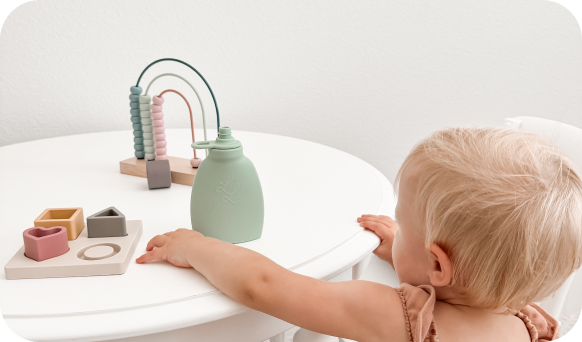Stage 1 Baby Food: 8 Simple Baby Puree Recipes To Start Your Baby’s Journey

Introducing your baby to solid foods is an exciting milestone but it can also feel overwhelming for new parents. Questions like What is stage 1 baby food? or How much should a 4-month-old eat? are common concerns during this stage. The good news? Stage 1 baby foods are simple or nutritious and easy to prepare providing your little one with the necessary vitamins and minerals to thrive.
In this guide, we’ll explain what stage 1 baby food is and its benefits and share 8 simple baby puree recipes to help start your baby’s solid food journey the right way. Read on to learn more.
What Is Stage 1 Baby Food?
Stage 1 baby food refers to smooth, single-ingredient purees specifically designed for babies around 4-6 months old who are just beginning their journey with solid foods. These purees are made to be gentle on your baby’s developing digestive system while introducing them to new flavors and textures in a safe, manageable way.
At this stage, babies are transitioning from milk or formula to solids, so the focus is on keeping meals simple, nutritious and easy to swallow. Stage 1 foods help your little one learn how to move food in their mouth, swallow, and experience eating beyond milk. Here are some of the key features of stage 1 baby Food:
Single Ingredients: Start with one food at a time, such as carrots, apples, or sweet potatoes, to make it easier to pinpoint any allergies or sensitivities. This also allows your baby to explore individual flavors.
Smooth Texture: Purees should be blended to a very fine consistency, ensuring they are lump-free and easy for babies to swallow. Babies are still learning to move food around their mouths, so a smooth texture is key.
Small Portions: Begin with 1-2 teaspoons once a day, gradually increasing to 1-2 tablespoons as your baby gets used to the process. Pay attention to your baby’s cues—stop feeding if they’re turning away or seem full.
Why Stage 1 Foods Matter
Stage 1 baby foods are crucial in building lifelong healthy eating habits. They introduce essential nutrients like vitamin A from carrots for vision and vitamin C from apples to boost immunity, ensuring your baby gets the nutrition they need to grow.
These purees also help babies in their baby food stages practice swallowing and develop the coordination required to eat thicker foods later on. By exposing your little one to various flavors early, you can reduce the chances of picky eating and encourage a love for healthy foods.
For a detailed breakdown of introducing solids and tips for creating nutritious first foods, visit our Ultimate Guide to Making Stage 1 Baby Food.
When Should You Start Stage 1 Baby Food?
While most babies are ready to start solids around 4-6 months, it’s important to look for signs of readiness:
Your baby can sit up with support.
They show interest in food (reaching for your plate).
They can hold their head up steadily.
Start slow if you’re unsure how much a 4-month-old should eat. Begin with small amounts—about 1-2 teaspoons once a day—and gradually increase to 1-2 tablespoons as your baby gets used to eating. Always consult your pediatrician before introducing solids.
The Nutritional Benefits of Stage 1 Foods
Stage 1 foods play a crucial role in your baby’s growth and development:
Vitamins and Minerals: Essential nutrients like vitamin A, C, and iron help with vision, immunity, and healthy development.
Digestive Support: Simple purees are gentle on little tummies, supporting digestion and reducing constipation.
Exposure to Flavors: Introducing a variety of flavors helps expand your baby’s palate and prevents picky eating later on.
8 Simple Baby Puree Recipes for Stage 1
These easy-to-make homemade baby puree recipes require minimal ingredients and preparation time, ensuring your little one gets the nutrition they need.

1. Sweet Potato Puree:
Sweet potatoes are a fantastic first food because they’re rich in vitamin A and gentle on digestion.
Ingredients:
1 small sweet potato
Water or breast milk (for blending)
Instructions:
Peel, chop, and steam the sweet potato until soft.
Blend with water or breast milk until smooth.
2. Carrot Puree:
Carrots are packed with beta-carotene, which supports eye health and immunity.
Ingredients:
2 medium carrots
Water or formula (for blending)
Instructions:
Peel, chop, and steam carrots until tender.
Blend with water or formula to create a silky texture.
3. Apple Puree:
Apples are naturally sweet and a great source of vitamin C for a healthy immune system.
Ingredients:
1 medium apple (peeled and cored)
Water
Instructions:
Steam the apple until soft.
Blend with a small amount of water until smooth.
4. Banana Puree:
Bananas are rich in potassium and fiber, making them an ideal first baby puree.
Ingredients:
1 ripe banana
Instructions:
Mash the banana with a fork until smooth.
Add a teaspoon of water or breast milk if needed.
5. Avocado Puree:
Avocados provide healthy fats essential for brain development.
Ingredients:
1 ripe avocado
Instructions:
Scoop out the avocado flesh.
Blend or mash until creamy.
6. Pear Puree:
Pears are easy to digest and help prevent constipation.
Ingredients:
1 ripe pear (peeled and cored)
Water
Instructions:
Steam the pear until soft.
Blend with water until smooth.
7. Spinach and Apple Puree:
This combination introduces greens while adding a sweet, familiar flavor from apples.
Ingredients:
1 handful fresh spinach
1 small apple (peeled and cored)
Water
Instructions:
Steam the spinach and apple until tender.
Blend until smooth.
8. Pumpkin Puree:
Pumpkin is rich in vitamin A and fiber, supporting digestion and healthy growth.
Ingredients:
1 cup pumpkin cubes
Water or breast milk
Instructions:
Steam the pumpkin until soft.
Blend with water or breast milk until smooth.
Looking for even more inspiration for simple, homemade purees? Check out our guide to Quick & Easy Baby Puree Recipes You Can Make in Minutes for additional ideas.
Tips for Feeding Stage 1 Baby Food
Starting solids can be simple and stress-free with the right approach. Introduce one new puree every 3-5 days to monitor for allergies. Use fresh, seasonal ingredients for maximum nutrition and flavor. Ensure purees are completely smooth and lump-free for easy swallowing, gradually thickening as your baby adjusts. These steps will help your little one enjoy a safe and positive start to solid foods.
Make Feeding Easy with The Palmetto Pouch
Introducing stage 1 baby food doesn’t have to be messy or stressful. The Palmetto Pouch makes feeding your baby simple, convenient, and mess-free—whether you’re at home or on the go. Designed with busy parents in mind, these reusable pouches are perfect for storing and serving homemade purees. Here is why parents love The Palmetto Pouch:
Safe and Non-Toxic: Made from high-quality, BPA-free materials that are safe for your little one.
Easy to Use: Leak-free and perfectly sized for small portions of purees.
Hassle-Free Cleaning: Dishwasher-safe and easy to clean, so you spend less time on cleanup.
Portable Convenience: Ideal for on-the-go feeding, whether you’re heading to the park, visiting family, or traveling.
Access More Baby-Friendly Recipes
Want even more nutritious meal ideas for your baby? Our Tiny Tastes Masterclass package includes countless baby puree recipes and tips for introducing solids perfect for busy parents. This package is available as a one-time purchase or comes free with our combo pack.
Summary:
Introducing your little one to stage 1 baby food is an exciting step toward a lifetime of healthy eating. These simple, nutrient-rich baby puree recipes are easy to make, gentle on your baby’s tummy, and packed with essential vitamins and minerals.
Start with these recipes, pay attention to your baby’s cues, and enjoy this special journey together. For hassle-free feeding, explore The Palmetto Pouch, a practical solution for enjoying homemade purees wherever life takes you.
References:
- Serenity Kids. (n.d.). Stage 2 Baby Food: What It Is & When to Start. Retrieved from https://myserenitykids.com/blogs/news/stage-2-baby-food
- BabyCenter. (n.d.). How Much Food Should My Baby Eat? A Visual Guide. Retrieved from https://www.babycenter.com/baby/solids-finger-foods/how-much-food-should-my-baby-eat-a-visual-guide_40005798
- The New York Times. (2024). The Health Benefits of Sweet Potatoes. Retrieved from https://www.nytimes.com/2024/11/18/well/eat/sweet-potatoes-health-benefits-recipes.html
- National Institutes of Health (NIH). (n.d.). Antioxidant Activity of Apples. Retrieved from https://pmc.ncbi.nlm.nih.gov/articles/PMC442131/
- Harvard T.H. Chan School of Public Health. (n.d.). Bananas: A Nutritional Powerhouse. Retrieved from https://nutritionsource.hsph.harvard.edu/food-features/bananas/
- Healthline. (n.d.). Pumpkin: Nutrition, Benefits, and Uses. Retrieved from https://www.healthline.com/nutrition/pumpkin
- 7. Solid Starts. (n.d.). Understanding Allergies in Babies. Retrieved from https://solidstarts.com/allergies-babies/
